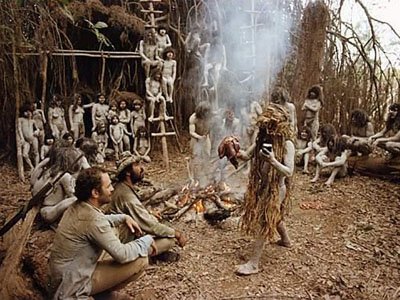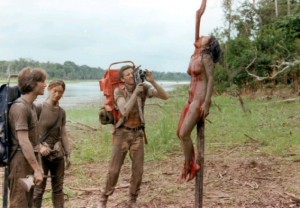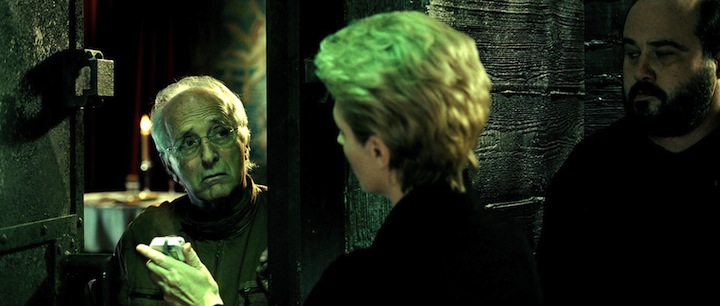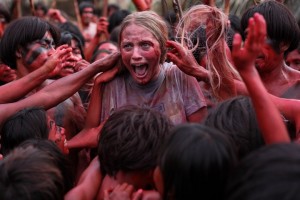 THE SHINING (1980); Dir. Stanley Kubrick; Starring Jack Nicholson, Shelley Duvall, Danny Lloyd and Scatman Crothers; Friday, June 6–Thursday, June 12 (see Plaza website for times and ticket prices); Plaza Theatre; Trailer here.
THE SHINING (1980); Dir. Stanley Kubrick; Starring Jack Nicholson, Shelley Duvall, Danny Lloyd and Scatman Crothers; Friday, June 6–Thursday, June 12 (see Plaza website for times and ticket prices); Plaza Theatre; Trailer here.
ROOM 237 (2012); Dir. Rodney Ascher; Starring Bill Blakemore, Geoffrey Cocks, Juli Kearns, John Fell Ryan and Jay Weidner; Friday, June 6–Thursday, June 12 (see Plaza website for times and ticket prices); Plaza Theatre; Trailer here.
By Aleck Bennett
Contributing Writer
The Plaza Theatre is presenting an intriguing pairing of films this month. Stanley Kubrick’s masterpiece of horror, THE SHINING, is being coupled with Rodney Ascher’s documentary on that film’s obsessives, ROOM 237. See both: marvel at Kubrick’s handiwork and then marvel at the interpretations offered up by the movie’s most hardcore fans.
Recovering alcoholic Jack Torrance (Jack Nicholson) has just accepted a job as the winter caretaker of the Overlook Hotel. The hotel, which was built on an Indian burial ground, gets snowed in and inaccessible during the winter, and constant care must be taken to ensure that the elements don’t take a toll on the building during those harsh months. The Overlook also has a troubled history—the previous caretaker lost his mind and killed himself and his family, and other horrors are suggested to have occurred during its many years of operation. Jack sees this assignment as a perfect time to get some writing done, and to rebuild his relationship with his family: wife Wendy and son Danny (Shelley Duvall and Danny Lloyd). However, Danny has “the shining”—the power of telepathy, and the ability to see visions of past and future events…a power that the hotel itself seems to share, and which could bring down the already-unstable walls of sanity that Jack Torrance has tried so hard to build.
Okay, last time we spoke, I described MARK OF THE VAMPIRE as being one of the more controversial classic horror movies. Well, THE SHINING is probably the most controversial modern horror film. It seems that most folks find no middle ground when discussing this movie: it’s either one of the greatest horror films of all time, or it’s an overrated piece of tripe. Very few people come away from it thinking “meh, that was okay.”
 Why is that? Well, there are a number of reasons.
Why is that? Well, there are a number of reasons.
Firstly, there’s the temperament of the viewer, and a lot depends on how they feel about the change in direction Stanley Kubrick’s films took with his 1968 science fiction epic 2001: A SPACE ODYSSEY. While his earlier films are certainly full of extended takes, deep focus and long tracking shots, those films are also more dynamic—typically full of emotionally-charged, dramatic moments. 2001 established that he was unafraid of presenting long takes in a quiet and lingering manner that seemed to examine the characters from a distance. The shots seem to emphasize the isolation of his movies’ central characters in an oppressive, surrounding environment. Paradoxically, the combination of deep focus and extended shot length creates an immersive experience: the viewer feels the same overwhelming subjective experience of the film’s characters, but the tone of Kubrick’s approach keeps the viewer knowingly at arm’s length from those characters. The viewer feels as if he or she is there, but still distanced from the action. Depending on your taste, you can find this compelling and suspenseful, or you can find it cold, detached and boring.
Secondly, there’s the question of fidelity to the film’s source. Stephen King has never cared for this adaptation of his novel (though his initial hatred of it has calmed over time). And that’s kind of understandable. The novel was written largely as a way of dealing with his own alcoholism and the anger issues he encountered as a husband and father, and to see his sympathetic stand-in Jack Torrance depicted as being pretty well off his nut right out of the gate…well, I might take it personally too. Beyond the treatment of Jack Torrance, King has been consistent in his criticism that the film abandons many of his own novel’s themes. King also felt that Kubrick (being a staunch atheist) tried to muddy the waters of the supposed reality of the ghosts that haunt the Overlook Hotel—that he shifted the balance too far in suggesting that the spirits seen are all products of the mind’s eye. So if you’re among those who feel that a filmed adaptation needs to remain as faithful to its source as possible (particularly if you’re also a fan of King’s novel), you may walk away disappointed.
Thirdly, there’s the question of the acting in the film. To be sure, everyone’s performances in the movie are pitched over the threshold of what is considered normal. Jack, Wendy and Danny are all higher-strung than your everyday family members. Jack isn’t just crazy, he’s berserk. Wendy’s not just growing more upset, she’s panic-stricken. Danny isn’t just frightened, he’s rendered wide-eyed and speechless. And it’s easy to get rubbed the wrong way by what can be seen as overacting.
 But, man, I can’t get on board with any of those criticisms.
But, man, I can’t get on board with any of those criticisms.
I’m a huge fan of Kubrick’s technique. His utilization of these long takes creates a tension that I find nearly unbearable. The viewer remains merely and consciously an observer to what’s going on. And as you witness the events of THE SHINING snowballing while the film progresses, it’s as if the film’s compositional structure itself is telling you that there’s not a single thing you can do to help these people. You can sympathize with them if you like, but you remain at a distance. It is a detached aesthetic, yes, but there is purpose behind it.
Also, when it comes to fidelity to source material, a filmmaker should not be forced into a promise to remain faithful to any work they’re adapting. Film and literature are two completely different animals; what works in one does not necessarily work in the other. And an adaptation is an interpretation by definition, not a direct copy of what is being referenced. Criticizing THE SHINING for straying from King’s novel is like criticizing Picasso for not painting a photorealistic depiction of the bombing of Guernica, or John Coltrane for recording a “My Favorite Things” that only glances occasionally at Rodgers and Hammerstein’s original composition. Kubrick has his own goals, and uses King’s source as a jumping-off point to achieve those goals. Judge his film on its own terms, not the terms King lays down in his novel. (If a close adaptation is what you seek, search out the 1997 TV mini-series. It’s remarkably close to its source novel, thanks to King adapting his own novel for the screen, while faithful King director Mick Garris helms the production. It’s also dreadful.)
 (Side note and potential spoiler: Kubrick fully expects you to come away believing that the ghosts are real. His aim, stated in interviews at the time, was to have the viewer question whether the hotel is really haunted, or if the visions are the product of Jack and Danny’s haunted minds until the latter choice becomes impossible. Ask yourself this: if the ghosts aren’t real, who opens the supply room door?)
(Side note and potential spoiler: Kubrick fully expects you to come away believing that the ghosts are real. His aim, stated in interviews at the time, was to have the viewer question whether the hotel is really haunted, or if the visions are the product of Jack and Danny’s haunted minds until the latter choice becomes impossible. Ask yourself this: if the ghosts aren’t real, who opens the supply room door?)
And then there’s the acting. I agree that it can be over-the-top. However, some things should be kept in mind: both Wendy and Danny are still traumatized by the abusive acts of Jack Torrance (which are only hinted at; one event of abuse is detailed, wherein Jack broke the young Danny’s arm, but the implication is that this is the only thing he did that left a physical mark and that Wendy is able to admit). So “naturalistic” acting is probably not something that would fit. Wendy is constantly in a nervous state of denial. Danny is withdrawn and in a constant state of unease. Additionally, everyone’s fragile state of mind is being affected by the presence of the power that permeates the very walls of the Overlook Hotel. And then there’s the technical issue that all of the actors simply must deliver large performances, lest they be completely overwhelmed by their surroundings. The Overlook is such a huge, overpowering presence, that meeker performances would be lost in competition.
And let’s not forget the set design of the Overlook itself. It doesn’t make any sense. Look at it. Windows to the outside are present in rooms nowhere near an outside wall. Paths taken through the hotel don’t add up. It is subconsciously upsetting because we constantly get a sense that something is wrong, but we can’t quite put our finger on why. The “why” is that we try to force a logical layout on the landscape that is rejected by the hotel itself. The Overlook is like some Escher-esque labyrinth of madness, waiting to ensnare anyone who wanders inside and who is sensitive to its forces. The repeated patterns of the hotel’s décor lull us into accepting that this is order. But these merely disguise the chaos that undulates underneath this superficial fabric.
 (In case I’m not making myself clear here, I love this movie.)
(In case I’m not making myself clear here, I love this movie.)
In short, it’s a masterpiece of horror cinema, and one of Kubrick’s most towering achievements. And like all great works of art, it has inspired debate and subjective interpretation. This is where Rodney Ascher’s documentary ROOM 237 comes in. Told entirely in voiceover and using a brilliantly conceived montage of images from Kubrick’s filmography and sources as disparate as SCHINDLER’S LIST and Lamberto Bava’s DEMONS, the film details the many theories and interpretations of Kubrick’s movie. These theories range from the outlandish (THE SHINING is an apology for Kubrick’s alleged part in faking the moon landing) to the less-outlandish (THE SHINING is a metaphor for the constant recurrence of violence in America) to the “let’s sync up THE WIZARD OF OZ and DARK SIDE OF THE MOON, man!” level of stoned college student ingenuity (THE SHINING is meant to be played forward and backward at the same time).
Smartly, the documentary doesn’t take a stance; just presents each person’s take on the film without judgment and allows you to evaluate each wildly differing interpretation on your own. For my money, the structure of the documentary is a little haphazard, jumping around from viewpoint to viewpoint, but it’s hard to argue with the ultimate brunt of Ascher’s film. This isn’t really about THE SHINING. This is about obsessive fandom. This is about film geekery. And to the subjects of ROOM 237, THE SHINING is like that elusive monolith in 2001: A SPACE ODYSSEY. It stands impenetrable, but if you could only touch it, it could unlock untold worlds. All of the narrators feel like they’ve touched it and come away with The Truth. But in reality, they’ve been sucked into the labyrinth that is the Overlook Hotel just like poor Jack Torrance. It’s just not quite as unsettling to see them navigate their way around it.
Aleck Bennett is a writer, blogger, pug warden, pop culture enthusiast, raconteur and bon vivant from the greater Atlanta area. Visit his blog at doctorsardonicus.wordpress.com












